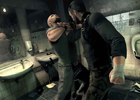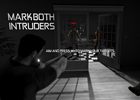Tom Clancy’s Splinter Cell: Conviction
| Genre: Action | ||
| Platform(s): Xbox 360, PC | ||
| Allegiance: Ubisoft | ||
| Vintage: 2010 | ||
| Rating: M | ||
| Intelligence Agency Report by: Zarhn X | ||
| Sam Fisher is back, and he’s more pissed off than ever. His daughter is dead and he is on the run from Third Echelon, the agency to which he gave the greater part of his life. | ||
|
|
||
| Weapons Expert Report by: Zarhn X | ||
| Story/Premise Gameplay Impact Visual Audio |
10.00 10.00 8.00 9.00 10.00 |
|
| Overall | 9.00 | |
| (not an average) | ||
| Version Reviewed: Xbox 360 I’m going to get this out of the way right now: this game is not 100% stealth-based like other Splinter Cell games. I repeat: it is NOT 100% stealth. While there are stealth elements in the game (and 85% of the game could probably be played in the shadows), Splinter Cell: Conviction gives more focus to the new action-based combat and gun play. Unlike the old Sam Fisher, this incarnation can survive a little more punishment, but he’s still human and can’t take too many bullets without biting the big one. The game also takes a weird turn with the art style. The graphics are great (aside from a few texture pop-ups), but the game gets weird when you enter the shadows and everything turns black and white. It’s nice to know that you’re hidden, but it changes the game from being lush and beautiful to a Sin City type of environment. While I got used to it about a fourth of the way through the game, it was still a bother.
The voices in the Splinter Cell games have always been great. The actor for Sam Fisher portrays him with a gruff tone of voice that fits the angry agent. The supporting voice cast does an admirable job too, as well as the voices of the hired goons (although they can sometimes get very repetitive). For the most part, the controls have remained the same throughout the Splinter Cell series, but this one takes a turn in a different direction. The basic controls are still the same, but the addition of the “Mark and Execute” ability changes the game dramatically. The basic gist of it is this: you mark enemies—the mark limit depends on the weapon, which is often upgradable to some extent—and after you pull the trigger, the game goes into a sort of slow-motion state in which Sam blasts enemies away in the order you marked them (or as some people put it, “press X to kill everyone). This technique is very deadly and most would say it doesn’t belong in a Splinter Cell game, and while I somewhat agree, what you have to realize is that Sam Fisher is a trained killer. He doesn’t have to follow the rules of Third Echelon anymore and is free to kill anyone and everyone. Another nice change was the addition of Jack Bauer-ish interrogation sequences in which you basically slam the guy into a series of objects until he talks. Simple, but very entertaining. The multiplayer aspect of the game has changed as well. You can now team up with a friend as another Third Echelon member and go through a story mode, or you can choose to do a basic “go around all kill this many people” type of mission. The narrative on the co-op story mode is barely there, but it’s still a nice addition to the game. There are also some new gadgets at Sam’s disposal. Most notable is the EMP backpack. Replacing the standard FN F2000 assault rifle from previous games, this backpack puts out an EMP charge that disables all electronics within 50 feet of Sam. It’s very helpful if you’re trying to be stealthy, and I think it’s an improvement over the gun of the previous games. Overall, with the numerous additions and the subtraction of purely stealth-based gameplay, I can say that this game is very good. It’s a change, sure, but in my opinion it’s a change for the better. It’s different, but it still maintains the Splinter Cell narrative and story flow everyone loves.
|
||




